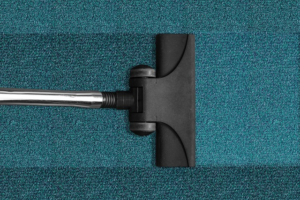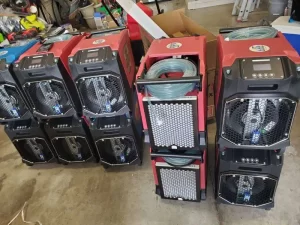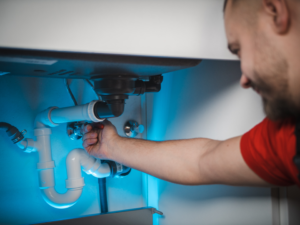Kitchen cabinets are one of the most important fixtures in this essential room, as they keep your food, dishes, and cooking utensils organized and out of the way.
However, they are unfortunately prone to water damage like other features – and it can be even more insidious than in other areas of the kitchen.
Because cabinets are flush with the wall, it’s easy for moisture to become trapped between these two surfaces, particularly if there’s a leaky pipe.
As such, you may not notice that there is water seeping into the fibers until there’s serious serious structural damage to the cabinets, and this can spell disaster for your kitchen – and your budget.
Today, we’ll discuss every aspect of the restoration process for wet cabinets, from why it happens to when you should call in the experts like TN Flood Kings.
MDF vs. Plywood: What’s the Difference?

Most kitchen cabinets are either medium density fiberboard (MDF) or plywood. Medium density fiberboard is an engineered product, similar to particle board, but it’s thicker and stronger. Because it’s made in a manufacturing facility rather than out in nature, you do not have to worry about rough spots or knots in the material.
Plywood, on the other hand, is made by gluing wood veneer sheets together. This also provides a nice finish, but it’s not quite as sturdy as MDF.
There are some other materials that can be used for a cabinet, but these are generally more expensive and less common.
How Water Damages Wooden Cabinets
Both MDF and plywood are wood products and, as such, are prone to water damage when excess water seeps into the material and begins to soften its fibers. The material will swell and bow, which can push it out of its braces and loosen the screws.
Heavier material means that the door hinges are being subjected to more pressure than they were designed for, and you may notice the doors sagging because the hinges can no longer handle their weight.
Another issue is that water damage encourages mold growth, which is not just unsightly but dangerous too. It’s essential that you repair the affected cabinets as soon as possible to avoid mold.
Signs of Water Damaged Kitchen Cabinets
The signs can be very subtle at first, but they will grow more obvious and severe as more damage occurs. Here are some of the common signs, starting from the least obvious to most:
- Excessive humidity in the cabinet
- Water stains and spots on the sides or door
- Warped or bubbling paint
- Standing water at the bottom of the cabinet
- Separating layers
- Mold growth
Can Water Damaged Wood Be Repaired?
This really depends on how extensive the issue is, as sometimes it’s easier and safer to simply get new cabinets than repair water damage.
In very severe cases, the water will run down and pool in the bottom of the cabinet; as the floor becomes damp, it can no longer handle as much strain as before, and you may find that all your pots and pans are plunged onto the floor.
With this circumstance, you likely need to replace the entire cabinet, as no repairs will help.
Signs of irreparable damage include:
- Bowed sides or floor
- Sagging cabinet doors
- Soft, crumbling wood
If you’re at all unsure about if you can handle your water damaged kitchen cabinets yourself, it’s always best to get a professional opinion from experts like TN Flood Kings. We can estimate the cost, help you make an insurance claim, and repair your cabinets so they’re good as new.
How To Repair Kitchen Cabinets After Water Damage

Many homeowners are leery of doing large home repairs because they feel that they won’t be able to, but depending on the level of damage, it can be relatively easy to deal with the problem. Let’s take a look at how to repair water damaged cabinets!
Call a Water Damage Restoration Company to Identify the Leak
First, you need to find and stop the leak. Potential water hazards include leaking pipes, unaddressed spills, and malfunctioning appliances. It can be tricky to track and source leaks, so it’s always best to reach out to a water damage restoration company like TN Flood Kings for assistance! We’re always happy to help!
Evaluate the Structural Damage
You’ll need to see exactly how much damage has been done in order to decide whether you should repair or replace it. If the sheets are soft and crumbling, then it might be best to buy new cabinets rather than trying to fix them. When you call Tn Flood Kings for a free estimate, we’ll help you decide whether these cabinets are worth saving or whether you should purchase new ones.
However, if it’s separated plywood or the damage is centered around one area, you can likely repair it.
Thoroughly Dry the Materials
Use thick towels and fans to completely remove all moisture from the area. You’ll want to wait a bit until everything is dry to the touch, and then wait a bit more to be sure everything has evaporated.
Repair or Replace the Cabinets
For this, you’ll need the following:
- Two boards
- Clamps
- Screws
- Carpenter’s glue
- Shellac-based primer
- Sander or sandpaper
- Paint
- Waterproofing varnish or seal
Remove the cabinet doors so you can access every area of the cabinet; you may also have to take off the toe kicks and move appliances out of the way.
Unscrew the cabinets and look for the areas that were warped by the water damage. Spread a thin layer of glue under the warped parts, then place the boards on the bottom and top and clamp securely. Let dry before completing any of the next tasks.
Once you’ve glued all the affected areas, cover them in a shellac primer. Let dry, then sand down and apply two layers of paint.
Lastly, use a waterproofing varnish or seal to make them more water resistant and place cabinets.
How to Protect Kitchen Cabinets From Water Damage

It’s essential that you prevent water damage as much as possible; after all, no one wants to go repair water damaged kitchen cabinets all over again!
Clean up any spills immediately: Being made of wood, kitchen cabinets are highly susceptible to water. No matter how small the spill, wipe it down and let it dry as soon as possible. You can open the windows and turn on the vents on your stove to hasten the process.
Inspect your kitchen cabinets often: You can’t fix something if you don’t know there’s a problem! Make it a habit to take a peek at the wood on a regular basis. You might find it helpful to install tap lights inside; this will not only make it easier to find things that have been shoved to the back, but it will also shed some light on any issues.
Don’t overdo it with cleaning materials: Cleaners have water, and you want to avoid this as much as possible. Use only as much as you need, and don’t douse any mold spots in cleaner: wipe it with a damp cloth and dry it instead.








